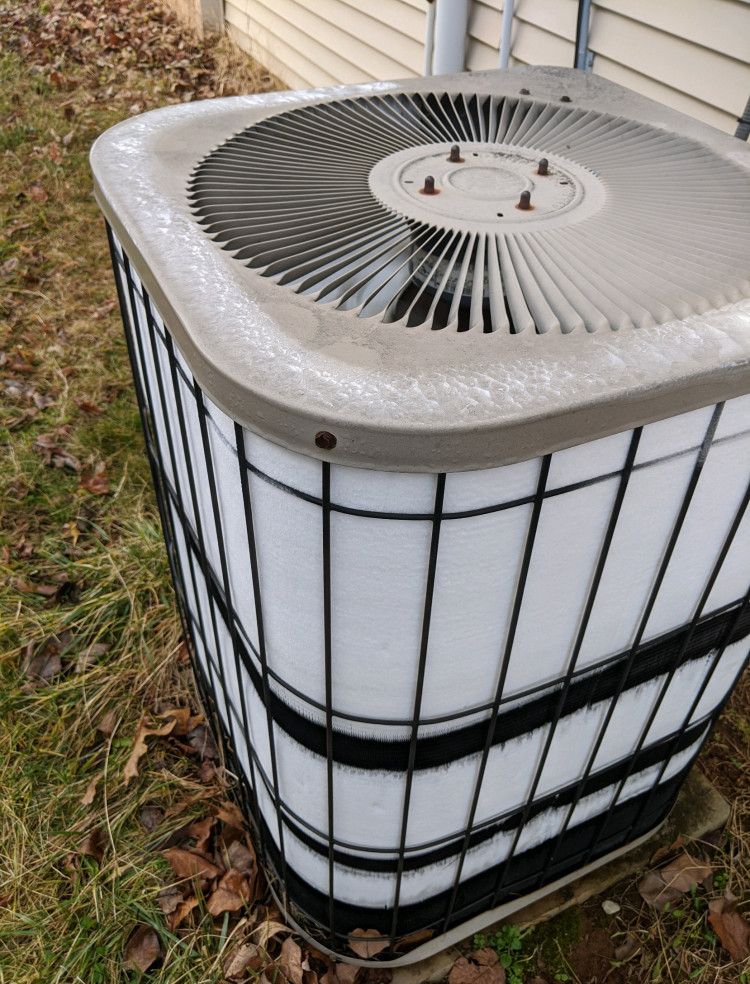
So you took a stroll around the house, why? Were you doing something else and just noticed that the coils on the outside unit were all-white with ice or were you feeling like the heat in your house was not quite what you thought it should be?
No matter what brought it to your attention, the point is that you have found a problem with your heat source. Now what?
The first thing that you don’t do is use water to try and melt the ice. The electrical components inside are designed to stand up against falling rain and not water being sprayed or poured on it. It would probably survive but you may not be so lucky.
You also should never try and remove the ice with any kind of tool. The chance of puncturing a line and causing things to go from bad to worse is real and could only be remedied by you digging even deeper into your pocket. Yea and a blow dryer will not cut it either.
So first things first. Is the outdoor unit running or is it silent? If it is running put your hand over the top to see if you feel the air blowing from the unit. If the blower is not running or blowing air but you still hear something humming (compressor). Then you have located your problem. *Maybe…
Ok, now go turn it off at the thermostat in the house.
How a Heat Pump Works

During the summer months, you can feel cool air coming from your vents in the house. If you were to go outside and feel the air being blown from the outside unit you will find it to be very warm or even hot. During the winter months, there is a reversing valve that does just what the name suggests, it reverses the process and the low-pressure refrigerant is pumped to the outside unit, and the high-pressure refrigerant is pumped to the indoor unit or coil. Low pressure being the cool side and high pressure being the warm side.
With the winter months being wet and cool, coupled with the cooling effect of the reversed heat pump; there is going to be frost forming on those exterior coils.
Normal, but when allowed to build up, will slow or block the flow of air across those coils, retarding the evaporative process which causes the temperature to drop inside the coils as the refrigerant does not evaporate but stays as a liquid.
The pressure differential changes the cooling dynamics which directly affects the heating. No ying no yang so to speak.
Defrost Cycle
To keep the frost from turning to ice there is a control, depending on the brand, that will temporarily reverse the process. The high pressure or hot condensed refrigerant gets pumped outside and the cool refrigerant gets pumped inside your house to the air handler.
This is called the defrost cycle. Now here is the catch. The motor or blower, not to be confused with the compressor, will stop turning or blowing as the heated refrigerant makes its way through the frosted coil, defrosting as it goes.
Also, the inside fan may shut off during this time as to not exchange the cold air into the house or the emergency heat will kick on warming the cool air now coming from the inside unit.
Did you catch that? Up above at the end of the second paragraph, I put an asterisk and the word *Maybe…
The reason being that you could experience the same mode of operation during a failed motor event at the exterior unit as the defrost cycle minus the operation of the interior blower motor.
It will still be running if the exterior motor fails and it will not be running during regular defrost mode, in some heat pumps.
The Reversing Valve and Controls

When the heat pump reverses nothing changes except the reversing valve. The compressor keeps pumping refrigerant out one port and sucking it back in another port. All this reversing is accomplished within the body of the reversing valve. This is engineered with an electrical solenoid actuated plunger that opens and closes ports, rerouting the freon.
What controls or initiates the defrost cycle can be different from one brand to another. The age of your unit could also be a factor in the control that was engineered into the works.
The majority of brands will have a variation of a control with a sensing bulb that detects a pressure/temperature drop at the outside unit. This incorporates a timer that starts the process. I found an article that would be a gem to bookmark and that goes in-depth on explaining how this all works. Follow the links to learn more.
How to Test Your Reversing Valve
If your reversing valve is doing nothing when you change the thermostat from heat to cool or visa-versa, then the problem may be the solenoid on the valve. With the power off, remove the leads to that solenoid and check for continuity with your meter. If the coil checks good and there is no power going to the reversing valve during your live test, then you may need a new control board.
Replacing Your Heat Pumps Outdoor Blower Motor
Let’s say that you have determined that your problem is a bad motor in the outdoor unit. At this point, I am going to suggest that you call a reputable AC repairman or a knowledgeable handyman to do the switch.
That is unless you have the tools, sufficient working experience with electricity, and the ability to complete the repair safely.
Ok, before we get started take your electrical multimeter, on the correct setting, check an outlet in your house to ensure you have a working meter.
Only after establishing that your meter is working, turn the power off to the heat pump at the main breaker panel. Going outside you may find that you also have a disconnect near your unit. Shut it off. It will either be a pull lever or a pull-out piece that separates from the face of the box.
WARNING: Most heat pumps will have a working voltage of 220-240 volts. I once was working on a residential central ac in Houston Texas that turned out to be a three-phase system. CHECK THE UNITS MANUFACTURES ID TAG
Now we are going to make sure that the unit has no power by first locating the service panel on the outside unit. It should be nearby where the power cable enters the unit. You will need either a 1/4 or 5/16 nut driver or both. Remove the cover and trace the supply power cable or wires to its first contact termination. This may be a terminal block or it may go directly to the contactor relay.
Either way, you want to set your multimeter to the correct voltage setting unless your meter is an auto range model. Test for voltage. Satisfied that all supply power is off, make your way to the fan capacitor and check its capacitance. The motor capacitor could be your problem and not the motor.
Check out the first video below on how to check a capacitor.
Extracting The Motor
Now scroll up to the picture of the iced-up heat pump at the top of this article and you can see a screw on the corner facing you. There will be a screw on all four corners. Remove them. Now, look at the top where the four studs come through the top or lid that you have removed the screws from. These are the fasteners that serve as the motor mounts.
Lift up on the top far enough to see the wires going to the motor and where they connect in the unit. Take note. Now find the tag on the motor and write down the Model, Serial, Voltage, Horse Power, and Rotation. With that information call around to your local AC Dealer or Mechanical Wholesaler to buy a motor.
Now that you have your motor, raise up on the top of the unit again, making sure the power is still disconnected, and follow the wires to their termination point and take a photo with your phone. You may be able to turn the cover upside down and set it on top of the unit with the motor facing up.
Unwire the motor. Now the top is free and you can take the top and motor to your garage or work area to remove and install the new motor. When you go to remove the fan blade and it is stuck, do not beat the end of the motor shaft with a hammer.
It will mushroom and then you will have to hacksaw the shaft to remove blades. Use a block of wood. It is always a good idea to spray WD-40 or PB Blaster to help loosen the hub from the shaft. Then take a pair of vise-grips and clamp down on the motor shaft between the fan hub and the motor. Then start turning the fan on the shaft loosening it and pulling up at the same time.
Reverse the whole process paying close attention to the wiring schematic on the side of the motor. It will probably be a universal motor with specific connections to make for your application including rotation.
When you are satisfied that you have made all of the correct connections and all the wires zip-tied out of the way of the fan operation then it is time to bring all your power back on. Turn the thermostat on for a live check of your motor installation.
Check that your new blower motor is blowing the air up and out of the unit and not sucking air down. If it is not blowing air up and out then you have the motor rotation wrong and have to go back and wire for the other direction. If you have bought a fixed rotation motor, then try and remove the blades and re-install the opposite direction.
Check out the second video for a detailed look at changing a motor.
